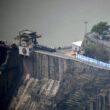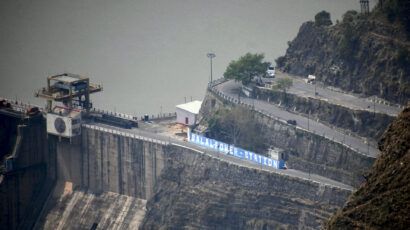Climate change, reactors, and bombs
By Hira Bahadur Thapa |
June's United Nations Conference on Sustainable Development, known as Rio+20, was criticized in many quarters for failing to produce binding agreements on climate change and other global issues. The criticism was justified, insofar as the international community has made so little progress in recent years toward addressing the potentially catastrophic effects of global warming, especially in the developing world. In my native country of Nepal, glaciers are retreating and creating new lakes that present terrible risks to people along riversides at lower elevations. The melting of Himalayan glaciers also threatens the supply of drinking water to millions of people in Nepal, India, and China.
Due to risks like these, it is only natural that developing countries — especially middle-income nations with high economic growth rates — are searching for alternatives to fossil fuels. Nuclear energy is among these alternatives; its ability to generate electricity without carbon emissions is one reason that a large number of developing countries, according to the International Atomic Energy Agency (IAEA), are considering the development of nuclear power sectors.
But several issues stand in the way of nuclear power's expansion in the developing world. The 2011 accident at the Fukushima Daiichi Nuclear Power Station, for example, dealt a severe blow to an industry that had expected to receive a boost from fears about climate change. The accident provided a reminder that, even if one acknowledges the positive aspects of nuclear power, serious dangers remain inherent in its use. The dangers include, along with incidents such as Fukushima, an increased risk of weapons proliferation.
But, complicating matters, an ongoing tension characterizes efforts to contain proliferation and to facilitate the spread of peaceful nuclear energy. To some extent, this tension dates to the days of President Dwight Eisenhower. The United States under Eisenhower strongly promoted the peaceful use of nuclear power around the world, and Eisenhower's "Atoms for Peace" program created a conducive atmosphere for the birth of the IAEA in 1957. But after all, it was the United States that had dropped two atom bombs on Japan in 1945. Even today, the IAEA's twin objectives of promoting peaceful nuclear applications while stopping the spread of nuclear weapons can sometimes seem at odds.
It would be an exaggeration to claim that the IAEA cares only about preventing military applications of nuclear technology, but at times the agency and its Board of Governors are portrayed as improperly favoring the most powerful member states — which seem to care much more about proliferation than about expansion of nuclear power. The agency has been accused of issuing flawed reports regarding the alleged proliferation activities of some NPT signatories; for example, a November 2011 report on Iran has come in for heavy criticism, and not just from Iranians. At the very least, the agency's commitment to facilitating the spread of peaceful nuclear technology does not seem to match the vigor it exhibits on proliferation questions.
Taking Iran as an example again, the IAEA and a number of major powers have been heavily engaged in efforts to stop that country's perceived weaponization. The latest negotiations between Iran and the five recognized nuclear weapon states, plus Germany, have not yielded positive results; but far more effort has been expended on Iran than seems to be devoted to helping developing countries exercise their inalienable right to nuclear power.
Something similar might be said regarding North Korea. That country's withdrawal from the NPT in 2003, and its tests of nuclear devices in 2006 and 2009, arguably sprang — at least in part — from a US failure to hold up its end of the bargain spelled out in 1994's Agreed Framework. Under that agreement, the United States was to facilitate construction of proliferation-resistant light water reactors in North Korea and to provide Pyongyang with heavy fuel oil to make up for the electrical capacity North Korea would lose by freezing operations at its existing nuclear reactor at Yongbyon. The light water reactors were never completed; the shipments of fuel oil were suspended in 2002. Today, a resolution to the North Korean nuclear crisis is as elusive as ever.
So the IAEA (and the major powers) failed to stop proliferation in the North Korean case and may be on the verge of failure in the Iranian case. To be fair, the agency is designed as a warning system, not as a police force; if it finds that a country is out of compliance with its obligations under the NPT, the only action at its disposal is to bring the noncompliance to the attention of the UN Security Council. Still, just as the Iranian and North Korean cases suggest that the IAEA is sometimes unable to meet the NPT's nonproliferation objectives, the agency also sometimes fails to facilitate the spread of nuclear technology's peaceful uses. Perhaps this suggests that a deep conflict is at work between promoting power reactors and banning nuclear weapons.
Obstacles and solutions. But the IAEA cannot be blamed for everything. Also unhelpful to the goal of expanding the peaceful utilization of the atom without introducing unacceptable risks is the role that commercial considerations sometimes play in nuclear issues. A case in point is the 2008 US-India nuclear cooperation agreement, and the arm-twisting that the world's only superpower exerted to convince the Nuclear Suppliers Group to grant India an exception to its export controls despite India's not being a signatory to the NPT. In this instance a nuclear-armed country outside the nonproliferation regime gained many of the benefits that participation in the regime would confer. Such an arrangement contributes nothing to the integrity of the nonproliferation regime, because all countries that aspire to the development of a nuclear energy sector should enjoy the confidence that others are playing the game fairly.
Still, despite all these difficulties, it might be possible to strike an acceptable balance between the benefits and risks of nuclear expansion — whether the risks are Fukushima-type accidents or the clandestine pursuit of nuclear weapons. Establishing such a balance might depend on the development of advanced reactor technologies with enhanced safety features, but additional useful steps could include multilateralization of the fuel cycle and a corresponding strengthening of the multilateral framework for the control of nuclear facilities and materials. If a strengthened framework were established, one in which all countries could place their confidence, safeguards and safety regimens could be steadily enhanced. Thus the way might be paved for a time when the peaceful atom could be embraced by all nations that could afford the cost. Such a day must be hastened if the most harmful effects of climate change are to be averted.















